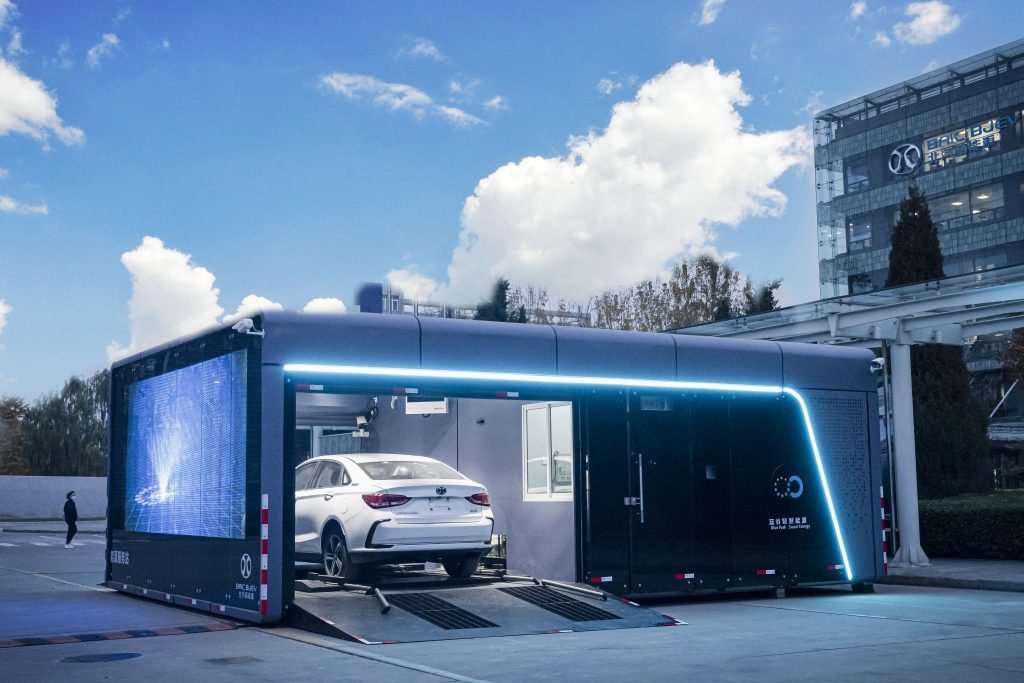Battery swapping: Stupid idea or next trend?
The one who standardizes batteries will rule electric vehicle market
By Kim Byung-wookPublished : July 27, 2021 - 16:54

Plucking batteries from electric vehicles and popping in fresh ones. This idea has existed since at least the late 2000s, but has apparently not been taken seriously by leading players in the sector.
In the lens of pessimists, the whiz-bang tech is nothing more than a relic of the early era of electric cars, when it used to take hours to recharge. Now, rapid chargers can juice batteries in less than 30 minutes and evolving technologies will make those times only shorter.
Critics dismiss battery swapping as a showroom tech that is impossible to implement in real life due to a lack of standardization. The designs of electric vehicles and batteries vary even within a single maker. This limits automation of swap stations from achieving economies of scale.
Despite the negative outlook, South Korea has designated battery swapping as a key agenda to pursue in its 40 trillion-won ($34.6 billion) investment plan announced July 8 to double down on the domestic battery industry.
According to the Industry Ministry, electric vehicles coming “Batteries Not Included” would cost below 20 million won per unit, as batteries take up roughly 40 percent of their total costs. Drivers could then buy monthly subscription plans to lease batteries. This would make electric cars more affordable to the general public.
Over the government’s push for battery swapping, local experts are expressing support, saying that cynics have overlooked the true worth of the tech.
“The ratio of EVs on the road currently stands at just 4.6 percent, so rapid chargers can handle them, even if it takes 15-30 minutes to fill up batteries. But when the ratio goes up to 10 to 20 percent, the rapid chargers won’t be enough,” said Lee Ho-geun, a professor of automotive engineering at Daeduk University.
The Korean government aims to raise the share of electric vehicles to 30 percent of all cars on the road by 2040, or 8.3 million units. Rolling out enough rapid chargers to service them could overload and destabilize the grid system, explains Lee.
“A typical four-bedroom apartment household consumes 5 kilowatts of electricity per hour. This means that a 50-kilowatt rapid charger sucks up the electricity of 10 households instantly.”
As for the matter of standardization, the expert added that the issue will be addressed eventually as battery technologies evolve.
“When next-generation batteries such as solid-state batteries are commercialized, battery packs will be much smaller in size and become easily swappable like changing cartridges.”
Lee Hang-gu, a senior researcher at the Korea Automotive Technology Institute, echoed professor Lee’s view. Increasingly more electric vehicles are becoming structurally alike, he said.
Major automakers such as Volkswagen, General Motors and Hyundai Motor all have developed platforms to load batteries on the floor of their passenger electric vehicles instead of the engine bay. This improves the balance and center of gravity.
The country leading the battery swap industry is China. According to a Katech report released in March, major Chinese automakers including Nio, Beijing Automotive Group and Geely have already launched battery swap businesses.
“When Chinese taxi, bus and cargo truck operators purchase EVs, the first thing they consider is the price. Cheap empty EVs capable of battery swaps are their perfect options,” an SK Innovation official said.
“Chinese automakers can’t afford to lose the giant domestic commercial vehicle market, so they are voluntarily standardizing their EVs and battery packs suitable for battery swaps.”
In January, SK Innovation purchased a 13 percent stake in Chinese battery swap station operator Blue Park Smart Technology, a subsidiary of Beijing Automotive Group. The station can swap batteries within three minutes, according to SK Innovation.
The SK Innovation official added the swap stations, where batteries are retrieved, kept, charged and maintained, can serve as vast networks of energy storage systems, offering another business model.
“Battery packs sitting there waiting for the next swap can be utilized as ESS, which can bank cheap electricity when demand is low and sell it back at higher prices when demand spikes during peak hours.”
Meanwhile, experts warn that China’s true intention in the battery swap business is to swallow and dominate unconquered electric vehicles markets and ultimately lead their global standardization.
“Chinese automakers can potentially sell their EVs and battery swap subscription model as a whole package in countries with weak charging infrastructure and set up an entry barrier against competitors,” said Lee Ho-joong, a researcher at Katech.
“If China’s battery swap system becomes a standard in some developing countries, consumers there will be fixed to the system and turn away from EVs incompatible with the system.”








![[KH Explains] Hyundai's full hybrid edge to pay off amid slow transition to pure EVs](http://res.heraldm.com/phpwas/restmb_idxmake.php?idx=644&simg=/content/image/2024/04/18/20240418050645_0.jpg&u=20240419100350)






![[From the Scene] Monks, Buddhists hail return of remains of Buddhas](http://res.heraldm.com/phpwas/restmb_idxmake.php?idx=652&simg=/content/image/2024/04/19/20240419050617_0.jpg&u=20240419175937)

![[KH Explains] Hyundai's full hybrid edge to pay off amid slow transition to pure EVs](http://res.heraldm.com/phpwas/restmb_idxmake.php?idx=652&simg=/content/image/2024/04/18/20240418050645_0.jpg&u=20240419100350)

![[Today’s K-pop] Illit drops debut single remix](http://res.heraldm.com/phpwas/restmb_idxmake.php?idx=642&simg=/content/image/2024/04/19/20240419050612_0.jpg&u=)